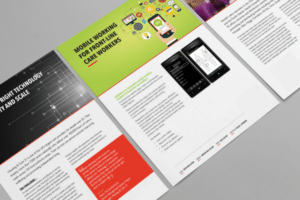Each day, there are millions of pieces of content added to the internet. Blog articles, infographics, white papers, and ebooks are published consistently over a wide range of platforms and mediums.
With all of this being created, it’s surprising that any brand would believe they need to start interactive content totally from scratch.
Many Rock Content customers feel that they have to write new content for every experience they make — even if the topic was recently covered in an article, blog, or white paper.
However, content creation is a time-consuming task. Writing, conceptualizing, proofing, approvals, all of this takes time; and time is money.
How about stopping wasting both and start repurposing and reimagining your static content?
In this article, we will talk about how you can repurpose static content and turn it into dynamic, interactive experiences. Here are the topics we’re about to cover:
- Why should you repurpose static content?
- How can you repurpose static content ?
- What are the main examples?
- Wrap Up
Why should you repurpose static content?
Let’s start with the “why”. Why should you choose to repurpose our content?
Repurposing, as the word already implies, means giving something a new purpose. So, it’s about taking what you have and applying it in another context to achieve a different goal.
Specifically, in our case, we’re talking about changing the pieces to make it more appealing for users and use it as a robust strategy to gather data and convert people.
It may be a long text-heavy blog post. It may be that one you’ve just thought about as you’re reading this.
Repurposing it could mean breaking it down into several interactive pieces, each one in a different format and style.

We get it! Your static content looks great, it performed well, and you subscribe to the “if it ain’t broke…” mentality. Well, we hate to be the bearer of bad news, but: it is broke.
We’re not saying that the content itself is bad, but your measurement and success metrics for that static piece are most definitely broke.
Interactive content gives you a whole new vision on metrics. Also, it provides you full control and monitoring of people’s responses.
Every time you write a blog post or design a beautiful PDF for download, you’re investing in one idea. That is: your users will not only download it, but they will also consume it and return to it repeatedly.
But, if that static PDF lives on their desktop or printed and tacked to their cubicle wall, you have no idea how important it was to them. Or unimportant, for that matter.
With an interactive piece, every move the user makes is known
Nothing gets lost. Every interaction becomes data that you can use to personalize your approaches and discover what your customers are after.
Besides, interactive content’s importance relies heavily on the fact that customers behave differently online today. They don’t want to consume content in a tiresome and exhausting experience. If they have to learn something new, they’d rather do it on a fun adventure.
After all, they’re already feeling fed up and overwhelmed with so much information available on the internet.
If you give them a game-based piece to play with, they will feel grateful. If you do that while teaching them something valuable about their career, they will love you.
Interactivity responds to human nature. It’s perfectly natural for us as humans to want something fun while learning. That’s why we prefer to engage in games and stories.
We pay more attention because it’s very much like we’re tricking ourselves into learning when it’s not the proper education/learning time.
So, you have to consider repurposing your content because interactivity engages people. That means your pieces can make them feel like part of a conversation.
If you rely strongly on a heavy copy as your only strategy, it may be harder to engage people. After all, users on the internet prefer videos, infographics, and visuals instead of just words.
Designhill even reported this as a trend: 80% of people will watch a video; only 20% will read a post.
How can you repurpose static content ?
Ok, now, it’s time for the “how”. Let’s give you some straightforward tips to help you go interactive!
1. Reimagine it into something else completely
Just because you wrote a static white paper, it doesn’t mean that you should immediately consider creating an interactive version of the same white paper.
White papers, ebooks, and research reports: all of those content types are heavy with copy and can be taken and reimagined as a completely different experience.
For example, a white paper probably has several key points that can be turned into a quiz or a calculator.
Let’s say that you wrote a white paper. It’s about the potential business cost of not having a cybersecurity system. Now, you want to send it to prospects to showcase the value of your services.
If you presented this white paper to us at Rock Content, we would immediately suggest an ROI Calculator that tells your audience about the cost associated with the lack of a cybersecurity system.
Symantec created something similar. They encouraged their prospects to answer questions about their current cybersecurity systems. Then, the company offered a white paper as further education about the topics.

This is an impactful approach because prospects are not only engaging with one piece of Symantec’s content.
In fact, they are now on a content journey that will move them further down the funnel.
2. Consider the Sales Funnel
Speaking of which, don’t forget the funnel. When taking some existing content, your team must consider it all the time.
Each type of content is more appropriate for each stage of the funnel, so you have to make the best choice.
For example, an ebook is useful for the earlier stages of the buyer’s journey, but not so much for later stages. A quiz and a game are also great for the first stage.
On the other hand, you have the assessment, the calculator, and the solution finder. The three of them are excellent for the buying process’s final moments since they are all about specific solutions to specific problems.
So, when you have to create new content out of the one you have already, ask yourself what’s the intention behind the original publication. Then, try to pick a possible option that perfectly matches that intention.
3. Test everything
Once you create your interactive content experience, it’s time to start testing. Test everything. Test multiple versions of it. Test the headline, the imagery, the CTA, the CTA placement, etc.
Test until you can’t imagine testing anymore and, then, test again. Your content will have the most longevity if you keep it fresh and different. The best way to do that is to iterate and update.
4. Use templates to get started quickly
Do not be turned off by the word “template”.
Template may sound like you’re going to get a cookie-cutter experience but trust me, that’s not the case. Templates, such as the ones which we refer to as Quick Starts, should be used as a base, not an exact roadmap.

In the above gif, an infographic was created for FPL on the left side; and the Quick Start is on the right.
You can see that though the structure and functionality are similar, the design elements tell a unique story.
The use of a Quick Start means that the development and backend work was already done for you, making your time to launch quicker and easier.
What are the main examples?
Ok, we’re still on the “how”. But, now, we’re going to show you some real examples of how to repurpose static content and reimagine it into something unique and interactive.
Interactive Content Toolkit
When you look at your traditional, regular content, what do you see that could be interactive? Do you ask the user questions about their product or services?

When scanning a piece, we need to look for questions that aim to get the user thinking. In the above GIF, created with our Interactive Content Toolkit, we’re asking the user to think about their current Content Marketing tactics.
These questions can be easily turned into a quiz or an assessment, which could provide the users the results that are more tailored to their business.
CMI report

It’s also necessary to spend time scanning content to find high-value stats or factoids that could be used in an interactive experience such as an infographic.
Additionally, you can turn stats into a quiz question that tests users’ knowledge. We did that with the recent CMI Report, which is available here.
Uberflip

Another one of our favorite customer examples was an experience created in partnership with Uberflip.
Their ebook, which you can see above, was full of beautiful design treatment, intended to capture your eye and inspire you to learn more about content creation.
We took that same piece and created an infographic teaser that encouraged the user to download the ebook.

This infographic above pulled the most impactful stats from the static ebook and turned it into an engaging teaser that encourages users to complete the form.
Uberflip was able to gain insights into what stats were most impactful in the experience, and they could, in turn, take that data and leverage it in a future piece.
Wrap Up
Interactive experiences are a game-changer in the content marketing world. They define the next big trend and the direction in which the market is heading.
To be active in this new era, you need to repurpose static content. Today, we showed you why and how you do that.
So, are you ready for the next steps? If you feel like getting great results with interactive content, request an Ion demo!
Start creating interactive content with Ion and increase your marketing results!
Start creating interactive content with Ion and increase your marketing results!








